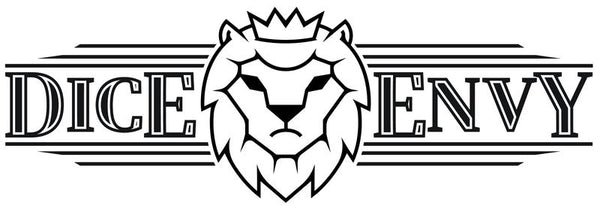D&D dice sets are the heart of any D&D or other tabletop RPG game. They’re the tools that you use to traverse the world, battle enemies, calculate the flow of events, and possibly create some new timelines along the way. They are fate distilled directly into an object in your hands. However, with so many pieces coming together to make a full set, there’s a lot to know before comfortably using them. Once you get familiar though, it doesn’t take a galaxy brain to understand. We’re going to break down the basics of D&D dice one by one.
The Pieces
A typical D&D dice set consists of 7 pieces. You can remember it because it matches the number of sins, all of which many D&D characters are guilty of. The pieces are d4, d6, d7, two d10s, d12, and d20. The numbers represent how many sides each die has. Some sets will also have more copies of one die to make things easier in the case of multiple roles. So, when you need to roll three d6s, you can roll them all at once rather than rolling a d6 three times. Because there’s nothing gamers love more than using the optimal strategy.
Common Uses
Most dice within a D&D dice set, the d4, d6, d8, d10, and d12, are used for combat functions. That includes damage, attacks, spells, and healing. When your enemies have chosen death, these are the dice you’re going to bust out. The d20, on the other hand, is used to check if attempted actions succeed. If you ever want to interact with anything, or just get real weird with it, this is the die to turn to. For more on D&D dice explained, we’re going to cover each die individually below.
Tetrahedron - d4
The d4 is a seldom appreciated part of a D&D dice set, mainly because it’s very easy to step on and hurt yourself. It also doesn’t roll very well because of the fewer, flatter sides. (Unless, that is, you have our patented infinity d4 dice!) The d4 is often used for low variation rolls, with an average of 2.5. You can use it for calculating damage from small weapons, which comes up pretty frequently. It’s also good for healing spells. If you want bigger, powerful spells, though, this die often won’t cut it.
Cube - d6

Everybody’s favorite, classic die of the D&D dice set is the cube. You’re likely already familiar with it, whether it’s from family-ending Monopoly games or a frustrating run through the game of Life. In terms of D&D, this die is used for quickly rolling multiples, such as attributes in character creation. How flexibly you implement multiple rolls is up to you. You can add an extra and discount the lowest roll if you want. Sometimes you just wanna play D&D on easy mode.
Octahedron - d8
The d8 is an eight-sided die with triangular faces. It’s essentially as if you took two pyramids and glued them together by the bottom. Its role in the D&D dice set is to determine the damage done by large weapons. So if you love swords, axes, maybe even a mace, this is the die you’ll rely on. If not, then it makes a great spinning top for you to mess around with during slower parts of the campaign.
Pentagonal Trapezohedron - d10

The two d10s you get for your dice set are slightly different but are used together. One has sides with 0-9, while the other has sides with multiples of 10, through 90. Their primary use for a D&D dice set is to be rolled together to get a percentage. So when you need to calculate anything based on a value between 1 and 100, these are your dice of choice. Note: two rolls of 0 equals 100, so you can never roll true zero. This die will fit in naturally for statistics lovers out there, not that there are any.
Dodecahedron - d12
Next up on D&D dice explained is the d12. Its role in a D&D dice set is to calculate damage for large weapons carried by a raging barbarian. For people that love going berserk on their enemies, this die will suit you perfectly. Design-wise, each face has a pentagonal shape, and stacks really well for long dice-stacking intervals between combat turns. You may not use this die the most within your run, but you can get some mileage outside of the run. At the very least, it looks pretty and brings the whole set together.
Icosahedron - d20
The grandmaster die of Dungeons and Dragons, the d20 is the premier member of your D&D dice set. For one thing, it has way more sides than the others. And it rolls way better than others because it’s closest to being spherical. Functionality-wise, it’s used any time you want to know your attempt was successful. That can be for attacks, skill checks, ability checks, and more, with each value representing a 5% chance. You roll a d20 to see if you hit an enemy, and then the others to see how the damage plays out. It’s the core, the great decider, RNGesus distilled into one essence present on your game board. It wouldn’t be inappropriate to pray to it to get good results throughout your campaign. It would be an outstanding move if you did, really.
Getting Started

Now that we’ve explained D&D dice sets to you, all you need to do is find the right D&D dice set for you and get started. Once you find the right set, everything else will fall into place. Just remember, sets are like snowflakes, no two are alike. It might take you a while to find the perfect set, but that’s okay. With all the different sets around Dice Envy, you’ll be sure to find something. Check out the collection of metal, stone, and polymer dice to start your D&D journey.
